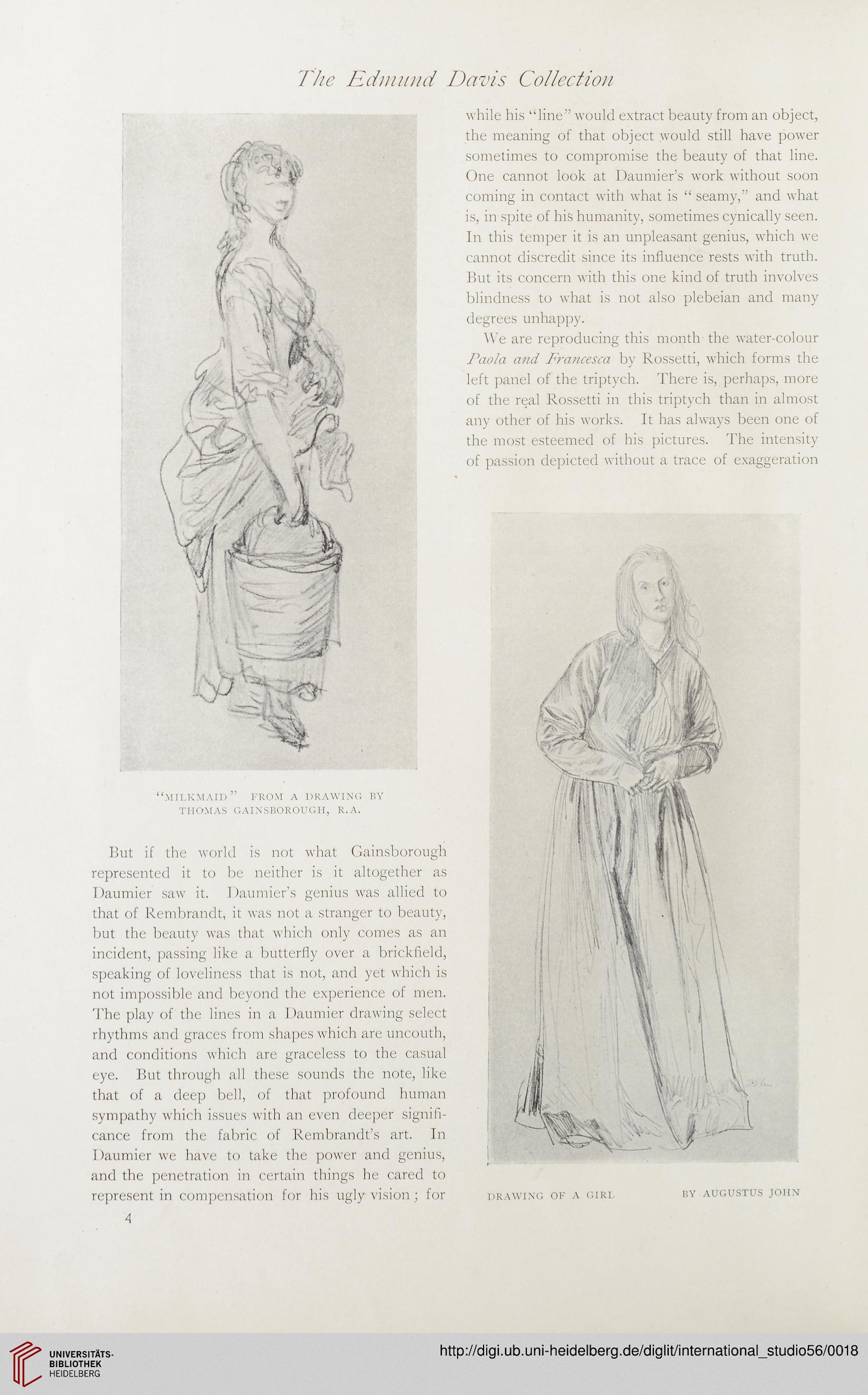The Edmund Davis Collection
“MILKMAID ” FROM A DRAWING BY
THOMAS GAINSBOROUGH, R.A.
But if the world is not what Gainsborough
represented it to be neither is it altogether as
Daumier saw it. Daumier’s genius was allied to
that of Rembrandt, it was not a stranger to beauty,
but the beauty was that which only comes as an
incident, passing like a butterfly over a brickfield,
speaking of loveliness that is not, and yet which is
not impossible and beyond the experience of men.
The play of the lines in a Daumier drawing select
rhythms and graces from shapes which are uncouth,
and conditions which are graceless to the casual
eye. But through all these sounds the note, like
that of a deep bell, of that profound human
sympathy which issues with an even deeper signifi-
cance from the fabric of Rembrandt’s art. In
Daumier we have to take the power and genius,
and the penetration in certain things he cared to
represent in compensation for his ugly vision; for
4
while his “line” would extract beauty from an object,
the meaning of that object would still have power
sometimes to compromise the beauty of that line.
One cannot look at Daumier’s work without soon
coming in contact with what is “ seamy,” and what
is, in spite of his humanity, sometimes cynically seen.
In this temper it is an unpleasant genius, which we
cannot discredit since its influence rests with truth.
But its concern with this one kind of truth involves
blindness to what is not also plebeian and many
degrees unhappy.
We are reproducing this month the water-colour
Paola and Francesca by Rossetti, which forms the
left panel of the triptych. There is, perhaps, more
of the real Rossetti in this triptych than in almost
any other of his works. It has always been one of
the most esteemed of his pictures. The intensity
of passion depicted without a trace of exaggeration
DRAWING OF A GIRL
BY AUGUSTUS JOHN
“MILKMAID ” FROM A DRAWING BY
THOMAS GAINSBOROUGH, R.A.
But if the world is not what Gainsborough
represented it to be neither is it altogether as
Daumier saw it. Daumier’s genius was allied to
that of Rembrandt, it was not a stranger to beauty,
but the beauty was that which only comes as an
incident, passing like a butterfly over a brickfield,
speaking of loveliness that is not, and yet which is
not impossible and beyond the experience of men.
The play of the lines in a Daumier drawing select
rhythms and graces from shapes which are uncouth,
and conditions which are graceless to the casual
eye. But through all these sounds the note, like
that of a deep bell, of that profound human
sympathy which issues with an even deeper signifi-
cance from the fabric of Rembrandt’s art. In
Daumier we have to take the power and genius,
and the penetration in certain things he cared to
represent in compensation for his ugly vision; for
4
while his “line” would extract beauty from an object,
the meaning of that object would still have power
sometimes to compromise the beauty of that line.
One cannot look at Daumier’s work without soon
coming in contact with what is “ seamy,” and what
is, in spite of his humanity, sometimes cynically seen.
In this temper it is an unpleasant genius, which we
cannot discredit since its influence rests with truth.
But its concern with this one kind of truth involves
blindness to what is not also plebeian and many
degrees unhappy.
We are reproducing this month the water-colour
Paola and Francesca by Rossetti, which forms the
left panel of the triptych. There is, perhaps, more
of the real Rossetti in this triptych than in almost
any other of his works. It has always been one of
the most esteemed of his pictures. The intensity
of passion depicted without a trace of exaggeration
DRAWING OF A GIRL
BY AUGUSTUS JOHN




